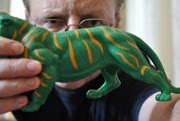I’m excited at the prospect of seeing the Eagle Owl that has set up shop in Bristol, near the University’s Biology department.
Owl
It’s thought to be an escapee from a private collection rather than a wild bird blown off course, but a creature with a wing span of up to 2 m sounds like a pretty impressive beast. The BBC’s Natural History Unit is based nearby, so perhaps it has got its beady eyes on a walk-on part on an upcoming production.
Not that I know much about birds, but generally I know what I like, and that’s the impressive, gaudy showbiz birds. Herons, spoonbills, kingfishers, that sort of thing. Don’t get me wrong, I can watch a flock of sparrows buzzing around for hours – their behaviour is interesting – but I don’t really share the twitcher’s urge to tick relatively mundane birds off the list just for a glimpse. When I see a flock of birdwatchers set up in a car park, because one of those birds in that huge pile of gulls just might be a rare Mediterranean gull – identical to all the other gulls apart from a minor detail of plumage – it leaves me pretty cold.
In the same way, I enjoy seeing the odd steam engine and nicely designed Intercity train, but don’t feel the need to get out the notebook and record the details of every diesel locomotive that passes through the station. Then again, the world needs obsessives, so good luck to them. It’s interesting to note that Martin Parr (him again) has at various times been a birdwatcher and a literal trainspotter, so maybe it’s the same species of obsession that drives on the best documentary and street photographers.
Unfortunately, street photography and trainspotting are both minority activities that fall outside the government-approved-behaviours-for-hard-working-families [list to follow]. Hence photographers, trainspotters and bus-spotter have had a tough time recently trying to pursue their interests in a climate of suspicion and paranoia.
Subscribe to:
Post Comments (Atom)

No comments:
Post a Comment